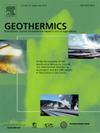Contemporary crustal stress in the Guangdong-Hong Kong-Macao Greater Bay Area, SE China: Implications for geothermal resource exploration and seismic hazard assessment
IF 3.5
2区 工程技术
Q3 ENERGY & FUELS
引用次数: 0
Abstract
Geothermal resources and seismic activity are two related earth science frontiers that are of great significance to socioeconomic development. The Guangdong-Hong Kong-Macao Greater Bay Area (GBA) in southeastern China is a geothermal resource-rich and seismically active region. Crustal stress information is crucial for identifying prospective hidden geothermal fields and assessing seismic hazards. However, the characteristics of crustal stress in the GBA region remain unclear. In this study, we construct a high-resolution three-dimensional (3D) geomechanical model of the GBA region with complex fault geometries and obtain the 3D stress state. The results show that the GBA region is subject to a laterally variable crustal stress field. The maximum horizontal stress (SH) is oriented predominantly NW-SE in the east of the study area and rotates to nearly N-S in the west. The shallow crust is dominated by a transpressional stress regime, while the deeper part exhibits transtension. Detailed stress analyses on typical individual faults show that the NW-trending faults commonly have low normal stresses and high dilation tendencies, thus favoring geothermal fluid circulation. In contrast, the ENE-/NE-trending faults, at high angles to the SH orientation, tend to act as barriers to fluid flow in the shallow crust and accumulate high strain energy, making them conducive to the generation of strong earthquakes. We propose a comprehensive conceptual model to illustrate the genetic mechanism of geothermal resources and strong earthquakes. This study is intended to promote the exploration of geothermal resources and support the seismic hazard assessment in the GBA region.
粤港澳大湾区当代地应力:对地热资源勘探和地震危险性评价的启示
地热资源与地震活动是两个相互关联的地球科学前沿,对社会经济发展具有重要意义。中国东南部粤港澳大湾区是一个地热资源丰富、地震活跃的地区。地应力信息是识别潜在地热田和评估地震危险性的重要依据。然而,大湾区地区的地应力特征尚不清楚。在此基础上,建立了具有复杂断层几何形状的大湾区高分辨率三维地质力学模型,获得了该区三维应力状态。结果表明,大湾区地区受横向变应力场影响。研究区最大水平应力(SH)在东部以西北—东南方向为主,在西部旋转至近北向南方向。浅部地壳以逆挤压为主,深部地壳以张拉为主。对典型断裂的详细应力分析表明,北西向断裂通常具有低正应力和高扩张倾向,有利于地热流体循环。相反,ENE-/ ne向断裂与SH方向成大角度,容易对地壳浅层流体流动起到屏障作用,积累高应变能,有利于强震的发生。我们提出了一个综合的概念模型来说明地热资源和强震的成因机制。本研究旨在促进大湾区地热资源勘探和地震危险性评价。
本文章由计算机程序翻译,如有差异,请以英文原文为准。
求助全文
约1分钟内获得全文
求助全文
来源期刊

Geothermics
工程技术-地球科学综合
CiteScore
7.70
自引率
15.40%
发文量
237
审稿时长
4.5 months
期刊介绍:
Geothermics is an international journal devoted to the research and development of geothermal energy. The International Board of Editors of Geothermics, which comprises specialists in the various aspects of geothermal resources, exploration and development, guarantees the balanced, comprehensive view of scientific and technological developments in this promising energy field.
It promulgates the state of the art and science of geothermal energy, its exploration and exploitation through a regular exchange of information from all parts of the world. The journal publishes articles dealing with the theory, exploration techniques and all aspects of the utilization of geothermal resources. Geothermics serves as the scientific house, or exchange medium, through which the growing community of geothermal specialists can provide and receive information.
 求助内容:
求助内容: 应助结果提醒方式:
应助结果提醒方式:


